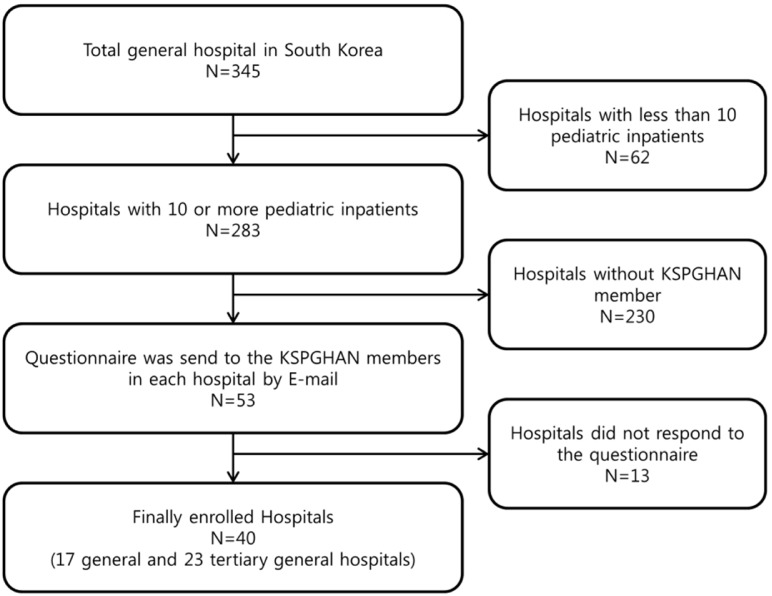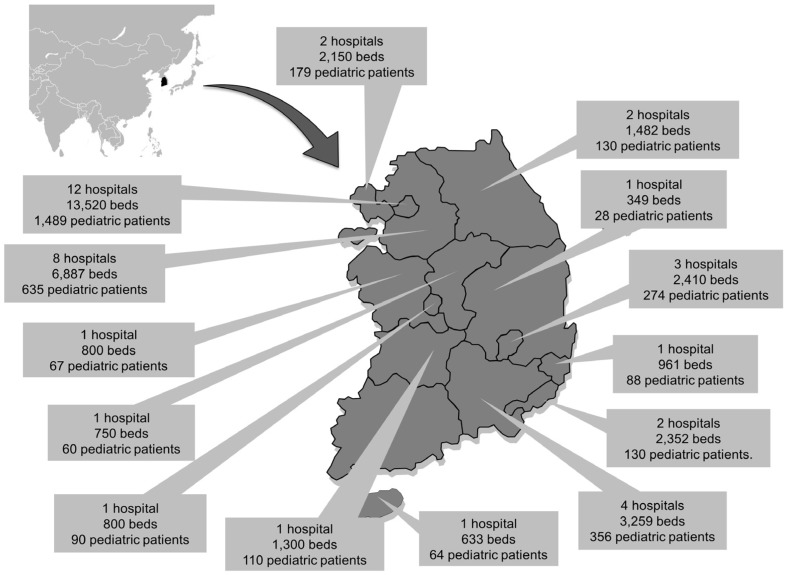Nutr Res Pract.
2018 Jun;12(3):215-221. 10.4162/nrp.2018.12.3.215.
Current status of nutritional support for hospitalized children: a nationwide hospital-based survey in South Korea
- Affiliations
-
- 1Department of Pediatrics, Severance Children's Hospital, Yonsei University College of Medicine, Seoul 03722, Korea.
- 2Department of Pediatrics, Eulji Medical Center, Eulji University College of Medicine, Seoul 01830, Korea.
- 3Department of Pediatrics, Seoul National University Bundang Hospital, Seoul National University College of Medicine, 82 Gumi-ro, Bundang-gu, Seongnam, Gyeonggi 13620, Korea. hryang@snubh.org
- KMID: 2442295
- DOI: http://doi.org/10.4162/nrp.2018.12.3.215
Abstract
- BACKGROUND/OBJECTIVES
The prevalence of malnutrition among hospitalized children ranges between 12% and 24%. Although the consequences of hospital malnutrition are enormous, it is often unrecognized and untreated. The aim of this study was to identify the current status of in-hospital nutrition support for children in South Korea by carrying out a nationwide hospital-based survey.
SUBJECTS/METHODS
Out of 345 general and tertiary hospitals in South Korea, a total of 53 institutes with pediatric gastroenterologists and more than 10 pediatric inpatients were selected. A questionnaire was developed by the nutrition committee of the Korean Society of Pediatric Gastroenterology, Hepatology and Nutrition. The questionnaires were sent to pediatric gastroenterologists in each hospital. Survey was performed by e-mails.
RESULTS
Forty hospitals (75.5%) responded to the survey; 23 of them were tertiary hospitals, and 17 of them were general hospitals. Only 21 hospitals (52.5%) had all the required nutritional support personnel (including pediatrician, nutritionist, pharmacist, and nurse) assigned to pediatric patients. Routine nutritional screening was performed in 22 (55.0%) hospitals on admission, which was lower than that in adult patients (65.8%). Nutritional screening tools varied among hospitals; 33 of 40 (82.5%) hospitals used their own screening tools. The most frequently used nutritional assessment parameters were weight, height, hemoglobin, and serum albumin levels. In our nationwide hospital-based survey, the most frequently reported main barriers of nutritional support in hospitals were lack of manpower and excessive workload, followed by insufficient knowledge and experience.
CONCLUSIONS
Although this nationwide hospital-based survey targeted general and tertiary hospitals with pediatric gastroenterologists, manpower and medical resources for nutritional support were still insufficient for hospitalized children, and nutritional screening was not routinely performed in many hospitals. More attention to hospital malnutrition and additional national policies for nutritional support in hospitals are required to ensure appropriate nutritional management of hospitalized pediatric patients.
Keyword
MeSH Terms
-
Academies and Institutes
Adult
Child
Child, Hospitalized*
Electronic Mail
Enteral Nutrition
Gastroenterology
Hospitals, General
Humans
Inpatients
Korea*
Malnutrition
Mass Screening
Nutrition Assessment
Nutritional Support*
Nutritionists
Parenteral Nutrition
Pharmacists
Prevalence
Serum Albumin
Tertiary Care Centers
Serum Albumin
Figure
Reference
-
1. Correia MI, Waitzberg DL. The impact of malnutrition on morbidity, mortality, length of hospital stay and costs evaluated through a multivariate model analysis. Clin Nutr. 2003; 22:235–239. PMID: 12765661.2. Agostoni C, Axelsson I, Colomb V, Goulet O, Koletzko B, Michaelsen KF, Puntis JW, Rigo J, Shamir R, Szajewska H. The need for nutrition support teams in pediatric units: a commentary by the ESPGHAN committee on nutrition. J Pediatr Gastroenterol Nutr. 2005; 41:8–11. PMID: 15990621.
Article3. Shaughnessy EE, Kirkland LL. Malnutrition in hospitalized children: a responsibility and opportunity for pediatric hospitalists. Hosp Pediatr. 2016; 6:37–41. PMID: 26644045.
Article4. Beck AM, Balknäs UN, Camilo ME, Fürst P, Gentile MG, Hasunen K, Jones L, Jonkers-Schuitema C, Keller U, Melchior JC, Mikkelsen BE, Pavcic M, Schauder P, Sivonen L, Zinck O, Øien H, Ovesen L. hoc group on Nutrition Programmes in Hospitals, Council of Europe. Practices in relation to nutritional care and support--report from the Council of Europe. Clin Nutr. 2002; 21:351–354. PMID: 12211176.
Article5. Lee JY, Kearns RA, Friesen W. Seeking affective health care: Korean immigrants' use of homeland medical services. Health Place. 2010; 16:108–115. PMID: 19840903.
Article6. Ladas EJ, Sacks N, Brophy P, Rogers PC. Standards of nutritional care in pediatric oncology: results from a nationwide survey on the standards of practice in pediatric oncology. A Children's Oncology Group study. Pediatr Blood Cancer. 2006; 46:339–344. PMID: 15926168.
Article7. ASPEN Board of Directors and the Clinical Guidelines Task Force. Guidelines for the use of parenteral and enteral nutrition in adult and pediatric patients. JPEN J Parenter Enteral Nutr. 2002; 26:1SA–138SA. PMID: 11841046.8. Kim J, Koh H, Chang EY, Park SY, Kim S. Single center experience with gastrostomy insertion in pediatric patients: a 10-year review. Pediatr Gastroenterol Hepatol Nutr. 2017; 20:34–40. PMID: 28401054.
Article9. Eglseer D, Halfens RJ, Lohrmann C. Is the presence of a validated malnutrition screening tool associated with better nutritional care in hospitalized patients? Nutrition. 2017; 37:104–111. PMID: 28359355.
Article10. Chittawatanarat K, Tosanguan K, Chaikledkaew U, Tejavanija S, Teerawattananon Y. Nationwide survey of nutritional management in an Asian upper-middle income developing country government hospitals: combination of quantitative survey and focus group discussion. Clin Nutr ESPEN. 2016; 14:24–30. PMID: 28531395.
Article11. Kondrup J, Allison SP, Elia M, Vellas B, Plauth M. ESPEN guidelines for nutrition screening 2002. Clin Nutr. 2003; 22:415–421. PMID: 12880610.
Article12. Schindler K, Pernicka E, Laviano A, Howard P, Schütz T, Bauer P, Grecu I, Jonkers C, Kondrup J, Ljungqvist O. How nutritional risk is assessed and managed in European hospitals: a survey of 21,007 patients findings from the 2007-2008 cross-sectional nutritionDay survey. Clin Nutr. 2010; 29:552–559. PMID: 20434820.
Article13. Joosten K, Meyer R. Nutritional screening and guidelines for managing the child with faltering growth. Eur J Clin Nutr. 2010; 64:S22–S24. PMID: 20442722.
Article14. Hartman C, Shamir R, Hecht C, Koletzko B. Malnutrition screening tools for hospitalized children. Curr Opin Clin Nutr Metab Care. 2012; 15:303–309. PMID: 22588189.
Article15. Annetta MG, Pittiruti M, De Rosa S, Franchi P, Pintaudi G, Caricato A, Antonelli M. Preventing hospital malnutrition: a survey on nutritional policies in an Italian University Hospital. Minerva Anestesiol. 2015; 81:1210–1218. PMID: 25375313.
- Full Text Links
- Actions
-
Cited
- CITED
-
- Close
- Share
- Similar articles
-
- Changes in health status of North Korean children and emerging health challenges of North Korean refugee children
- Assessment of Nutritional Status in Hospitalized Pediatric Patients
- The Current Status and the Perspectives of Nutrition Survey
- Changes in the Nutritional Status of Children from North Korean Refugee Families Following Resettlement in South Korea
- The Influence of Pediatric Nutrition Support Team on Hospitalized Pediatric Patients Receiving Parenteral Nutrition



